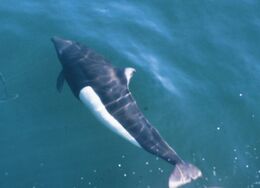
Dall's porpoises are "high strung," fast swimming members of the porpoise family and are common in the North Pacific Ocean. They can reach a maximum length of just under 8 feet (2.4 m) and weigh up to 480 pounds (220 kg). Males are slightly larger and thicker than females, which reach lengths of just under 7 feet (2.1 m) long. Animals in the eastern Pacific are smaller than those in the western Pacific and waters around Japan.
Dall's porpoises have a relatively small, triangular head with little or no beak and a thick, robust body. The flippers are small, round, and located forward on the body. The dorsal fin is positioned in the middle of the back, triangular in shape, and often cant, or angles, forward. The tail stock and "keel" (otherwise known as the "caudal peduncle") are exaggerated and create a pronounced hump, which is large compared to other marine mammals. Adult males have a thicker tail stock and forward projecting dorsal fin. The body is very dark gray or black in coloration with variable contrasting white "thoracic" panels and white "frosting" on the dorsal fin and tail that distinguish it from other cetacean species. These markings and colorations vary with geographic location and life stage, with adults having more distinct coloration.
Taxonomically, Dall's porpoises are separated into two major morphs/ types/ subspecies: the truei-type and the dalli-type. The truei-type (P. d. truie) is common in the Western Pacific Ocean (between 35°N and 54°N), and the dalli-type (P. d. dalli) is common throughout the North Pacific Ocean. The two types can be distinguished by the location and size of the white thoracic panels. All black (melanistic) and all white (albino) forms also exist, but are considered rare. Hybrids between Dall's porpoises and harbor porpoises are also fairly common in the Northeast Pacific, but can also occur elsewhere.
These porpoises are usually found in groups averaging between 2-20 individuals, but have been occasionally seen in larger, loosely associated groups in the hundreds or even thousands of animals. They are known to associate with Pacific white-sided dolphins and short-finned pilot whales, but have also been seen bowriding on large rorquals (whales in the Balaenopteridae family). As rapid, gregarious swimmers, they are also attracted to fast moving vessels and commonly bowride.
They feed on small schooling fish (e.g., anchovies, herring, and hake), mid- and deep water fish (e.g., myctophids and smelts), cephalopods (e.g., squid and octopus), and occasionally crabs and shrimp. Feeding usually occurs at night when their prey vertically migrate up toward the surface. Dall's porpoises are capable of diving up to 1640 feet (500 m) in order to reach their prey. They have 38-56 very small spade-shaped teeth on each jaw that are useful for grasping. Their brisk surfacing while swimming creates a "rooster tail" of water spray that is a unique characteristic of the species.
Dall's porpoises become sexually mature at 3.5-8 years of age and give birth to a single calf after 10-12 months, usually between June and September. The calves are generally 3.3 feet (1 m) long. Calves are typically nursed by their mother for less than one year. These cetaceans can live up to 22 years, but their lifespan is generally 15-20 years.
Habitat[]
This species prefers temperate to "boreal" waters that are more than 600 feet (180 m) deep and with temperatures between 36°F (2°C) and 63°F (17°C). They can be found in offshore, inshore, and nearshore oceanic waters.
Distribution[]
Dall's porpoises occur throughout the North Pacific Ocean. This species is also found in the adjacent Bering Sea, Sea of Japan, and Okhotsk Sea. In the eastern North Pacific, they occur from around the U.S./Mexico border (Baja California) (28-32°N) to the Bering Sea (65°N); in the central North Pacific (above 41°N); and in the western North Pacific from central Japan (35°N) to the Okhotsk Sea. In the Bering Sea, they occur in higher abundance near the shelf break. There are some migration patterns, inshore/offshore and north/south, based on morph/type, geography, and seasonality.
Population Trends[]
For management purposes, Dall's porpoises inhabiting U.S. waters have been divided into two stocks: the Alaska Stock and the California/Oregon/Washington Stock. For both stocks, there are insufficient data available on current population trends. However, Dall's porpoises are considered reasonably abundant. For example in the North Pacific there are possibly 1.2 million animals. In U.S. waters, it is estimated that there are 130,000 individuals, including 76,000-99,500 off the U.S. west coast (California, Oregon, and Washington) and 77,000-83,500 for the Alaska stock. In the western North Pacific, there are an estimated 100,000 off of Japan and several hundreds of thousands of Dall's porpoises in the Okhotsk Sea (Shirihai and Jarrett, 2006).